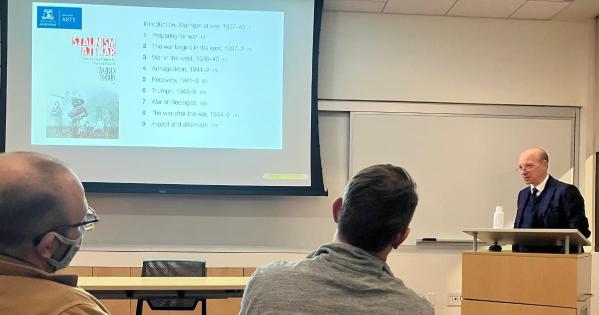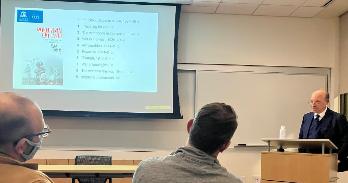Dr. Mark Edele "Stalinism at War" book talk

On 18 November 2022, the Carmel Institute partnered with Georgetown University’s Russian History Seminar on a talk by Dr. Mark Edele about his latest book Stalinism at War: The Soviet Union in World War II (Bloomsbury, 2021). Inaugural Hansen Professor in History at the University of Melbourne, Australia, Dr. Edele also serves as Deputy Dean in the Faculty of Arts. He is a historian of the Soviet Union and its successor states, in particular Russia. A former Australian Research Council (ARC) Future Fellow, he has served as Deputy Head of the School of Historical and Philosophical Studies (SHAPS) at the University of Melbourne and as Deputy Associate Dean (academic performance) in the Faculty of Arts. He was trained as a historian at the Universities of Erlangen, Tübingen, Moscow, and Chicago. His publications include Soviet Veterans of the Second World War (2008), Stalinist Society (2011), Stalin’s Defectors (2017), Shelter from the Holocaust: Rethinking Jewish Survival in the Soviet Union (edited with Atina Grossmann and Sheila Fitzpatrick, 2017), The Soviet Union. A Short History (2019), Debates on Stalinism (2020), and The Politics of Veteran Benefits in the Twentieth Century. A Comparative History (2020).
Anyone looking for a readable and thought-provoking primer about the Second World War need look no further than Stalinism at War. Edele reframes the conflict by splitting it up into five distinct but overlapping stages: the Asian land war (1937-1945), the European war (1939-1941), the north African war (1940-1943), the German-Soviet war (1941-1945), and the Pacific war (1941-1945). While they combined into a perfect storm in late 1941, the civil wars continued until 1949, when large-scale deportations in the west and the victory of Chinese communists in the east marked the end of the Soviet Second World War. In other words, Edele recasts the Soviet Union’s Great Patriotic War (1941-1945) as part of “a long Eurasian war stretching from 1937 to 1949.” The nine maps at the end of the book help tie the stages together visually—a rare find in books dealing with the Second World War that usually divide it into distinct theaters with maps unrelated to each other.
Edele starts out by giving new weight to the largely neglected Soviet victories over Japan in the late 1930s, to pan-Eurasian displacement, and to the multinational character of those fighting and suffering. Edele stresses the importance of Chiang Kai-Shek’s refusal to surrender to the Japanese. In August 1937, Moscow concluded the Mutual Nonaggression Treaty with Chiang’s government, which opened the way for massive military aid and “5,000 Soviet pilots, advisors, medics and technicians” to help the Chinese tie down the Japanese beyond Soviet borders. Meanwhile, the Soviet satellite state of Mongolia became “a model for similar arrangements in Eastern Europe after the Second World War.” The months-long battle of Khalkhin Gol around the issue of the Mongol-Manchukuo border was more than a border skirmish, but “a small undeclared war” and the culmination of the Soviet-Japanese border war of 1938-39, which itself was part and parcel of the global Second World War. It also became a testing ground for Zhukov’s coordinated “deep battle” tactics. The Soviet victory bolstered the Japanese proponents of the “southern” or “Pacific” strategy and saved the USSR from a two-front war even as the Wehrmacht stood on the outskirts of Moscow in December 1941. The defensive nature of the Soviet Union’s Far Eastern conflict both enabled and contrasted with its imperialist strategy in the West.

The early start to Soviet industrial-military production in the early 1930s enabled the Soviets to defeat Japan and avoid a two-front war, but it also left them “with tens of thousands of obsolete tanks and planes” by decade’s end. “The Stalinist industrial system thus combined effectiveness with inefficiency,” Edele argues, and intriguingly observes that the Soviets were “ready to be unprepared: the entire experience of the 1930s had nurtured a culture of improvisation which accustomed officials and rank-and-file citizens to the trouble shooting necessary at times of war.”
Although the human and territorial losses during the first year of the war dwarfed anything that Russia had experienced before, “Stalin’s regime did not buckle.” And part of the secret was the re-calibration from a “planned” to a “command” economy where “the center demanded, the localities produced” and the Kremlin’s plenipotentiaries “circled like satellites around the stationary center of the system, [Stalin]” directing the “Janus-faced process of centralization and decentralization.” Meanwhile, the “feminization” of the Soviet economy behind the front lines constituted a “continuation of a pre-war trend rather than a radical change.”
Edele extends the history of the Great Patriotic War to the post-conflict years as the Soviet state dealt with partisan groups in the Western borderlands and the massive crime wave that engulfed Soviet society after the war. Clamping down on separatism and domestic opposition, Stalin supported the Chinese communists to tie down Chaing Kai-Shek’s government “to secure the eastern flank of the Soviet Union during the critical transition from war to peace.” But once the communists came to power, Stalin “made sure that Mao would support” Kim Il-Sung in his attempt to reunite Korea to keep China’s new masters occupied and off balance.
The final chapter mentions two things of interest. First, the Soviet state was initially reluctant to lionize war veterans with the excuse that its ideology favored the working class, not “old soldiers, the preoccupation of fascists.” Veterans would have to wait until Brezhnev’s time to receive full state recognition and special pensions. Second, an unexpected outcome of the war was “the emergence of the ‘gardening state’” that tolerated private land plots after the war and finally enshrined its support for them in the Brezhnev-era 1977 constitution.
The book talk brought together faculty and students from the consortium universities as well as alums and guests from town. All in attendance enjoyed a reception after the book talk where the conversation continued well into the evening.
